Utilization of Biodegradable Wastes as a Clean Energy Source in the Developing Countries: A Case Study in Myanmar
Abstract
1. Introduction
2. Background of the Study
3. Materials and Methods
3.1. Collection of the Samples
3.2. Methods
3.2.1. Assessment of the Moisture Contents of the Samples
3.2.2. Assessment of the Moisture Reduction, Weight Reduction, Volume Reduction, and Heating Value Increase of the Samples
- LHVinitial and LHVfinal are the initial lower heating values and final lower heating values of the samples (megajoules per kilogram (MJ per kg)), respectively.
- Davg is the average dry mass of the biodegradable wastes in mass (kg) (assumed as 0.2 kg, based on the fact that the total weight and the moisture content of the biodegradable wastes are 1 kg and 80%, respectively).
- Wi is the initial weight of a waste component i in the total initial weight of the waste composition (kg).
- Wj is the final weight of a waste component j in the total final weight of the waste composition (kg).
- MCi and MCj are the initial and final moisture content of the waste component i and j (%).
- Ei is the energy content of a waste component i (MJ per kg).
- n is the total number of the waste types in the total waste composition.
3.2.3. GHG Emissions and Avoidance from Anaerobic Digestion of the Biodegradable Wastes
- NGHGAD is the net GHG emission/avoidance from anaerobic digestion (kg CO2 per tonne of organic waste).
- ADemission is the GHG emissions from the treatment of anaerobic digestion (kg CO2 per tonne of organic waste).
- ADavoidance is the GHG avoidance due to the energy recovery from anaerobic digestion and due to avoidance of landfilling of the equivalent amount of organic wastes used for anaerobic digestion (kg CO2 per tonne of organic waste).
- ECH4 is the emissions of CH4 due to leakages (kg of CH4 per kg of dry matter) (assumed as 2 kg of CH4 per tonne of dry organic wastes).
- DM is the dry matter percentage in the influent (%) (assumed as 20%).
- is the conversion factor to calculate dry matter content per tonne of organic waste.
- GWPCH4 is the global warming potential of CH4 (21 kg CO2 per kg of CH4).
- CBiogas is the collected amount of biogas (m3 per ton of organic waste) (assumed as 592 m3 per tonne of dry mass).
- PCH4 is the percentage of CH4 in biogas (%) (assumed as 60%).
- ECCH4 is the energy content of CH4 (MJ per m3) (assumed as 37 MJ per m3).
- EFCO2 is the emission factor of CO2 by combustion of liquid petroleum gas (LPG) (kg of CO2 per MJ) (assumed as 0.063 kg of CO2 per MJ). Despite having two possible substitutions from biogas into thermal energy or from biogas into electricity, it was assumed that LPG consumption was substituted by using biogas as the thermal energy source.
- GHGLFavoidance is the GHG avoidance from landfilling of the equivalent amount of organic wastes calculated as per the Equation (4) below. The considerations for the GHG emissions from fossil fuel consumption for operation activities during anaerobic digestion were not included for ease of estimation.
3.2.4. GHG Emission from Waste Disposal of Biodegradable Wastes at Open Dumpsites
- CH4 Emission is methane emission from landfill in gigagrams per year.
- MSWT is the total solid waste generation (Gg per year).
- MSWF is the fraction of solid waste disposed of, on the wet weight bis.
- MCF is the methane correction factor (0.6 as a recommended value of IPCC for uncategorized landfill).
- DOC is the degradable organic carbon in MSW (0.1042, derived from IPCC default DOC values).
- DOCF is the fraction of DOC that can decompose (fraction) (0.5 as a default value of IPPC).
- F is a fraction of CH4 in generated landfill gas (0.5 as a default value of IPPC).
- R is the recovered methane (Gg per year) which is zero for open dumpsites with no gas collection system.
- 16/12 is the molecular weight ratio of methane to carbon, and OX is the oxidation factor, which is zero for open dumpsites as a recommended value of IPCC.
3.2.5. GHG Emission from Transportation
- GHGT is GHG emissions from transportation (kg CO2 per tonne of transported waste).
- F is the total amount of fossil fuel consumption per month, (Diesel in litres and Natural gas in kg).
- W is the total amount of waste transported per month (tonnes per month).
- E is the energy content of fossil fuel (36.42 MJ per litre for diesel and 37.92 MJ per kg for natural gas).
- EF is the CO2 emission factor of the fuel (0.074 kg CO2 per MJ for diesel and 0.056 kg CO2 per MJ for natural gas).
3.2.6. Fossil Fuel Savings and GHG Emissions/Avoidance from Fossil Fuel Consumption and Utilization of the Biodegradable Wastes
- FFS is the amount of fossil fuel that could be saved by utilization of the biodegradable wastes (kilotonnes per year).
- Wb is the amount of the biodegradable wastes (kilotonnes per year).
- Eb is the energy content of the biodegradable wastes (MJ per kg) (assumed as 3.5 MJ per kg of the biodegradable waste).
- Eff is the energy content of the fossil fuel (MJ per kg) (assumed as 30 MJ per kg of black coal).
- GHGF is the total estimated amount of greenhouse emissions from fossil fuel consumption (Gg of CO2-eq per year).
- EF is the total estimated quantity of the energy content of fossil fuel (GJ per year).
- EMF is the total estimated amount of CO2 emission from fossil fuel consumption (kg of CO2 per GJ).
3.2.7. GHG Emission Avoidance from Avoiding Waste Disposal at Open Dumpsites
3.2.8. GHG Emission Avoidance from the Utilization of Biodegradable Wastes
4. Results and Discussion
4.1. Properties of Biodegradable Waste Samples before and after Drying
4.2. The Effect of Moisture Reduction on Weight Reduction, Volume Reduction, and Heating Value of the Biodegradable Wastes of Myanmar
4.3. GHG Emission/Avoidance from Biodegradable Waste Disposal and Biodegradable Waste Utilization
5. Recommendations
6. Conclusions
Author Contributions
Funding
Acknowledgments
Conflicts of Interest
References
- Hwa, T.J. Overview of Solid-Waste Management in Asian Countries. Solid Waste Management, Issues and Challenges in Asia; Asian Productivity Organisation: Tokyo, Japan, 2007; pp. 3–7. ISBN 92-833-7058-9. [Google Scholar]
- Hoornweg, D.; Bhada-Tata, P. What a Waste: A Global Review of Solid Waste Management; Urban Development Series Knowledge Papers; The World Bank Group: Washington, DC, USA, 2012; pp. 1–98. [Google Scholar]
- Population 2012 Country Ranks, by Rank. March 2012. Available online: https://photius.com/rankings/population/population_2012_0.html (accessed on 11 October 2018).
- Tun, M.M.; Juchelková, D. Problems with Biodegradable Wastes—Potential in Myanmar and Other Asian Countries for Combination of Drying and Waste Incineration. In Proceedings of the IRRC Waste to Energy Conference, Vienna, Austria, 1–2 October 2018. [Google Scholar]
- Whiteman, A.; Gupta, S.K.; Briciu, C.; Bates, S. Collaborative Working Group: Solid Waste Management in Low- and Middle-Income Countries. Waste to Energy Rapid Assessment Tool. 2016, pp. 1–30. Available online: http://www.seas.columbia.edu/earth/wtert/sofos/CWG.PDF (accessed on 11 October 2018).
- Yuan, J.; Zhang, D.; Li, Y.; Chadwick, D.; Li, G.; Li, Y.; Du, L. Effects of adding bulking agents on biostabilization and drying of municipal solid waste. Waste Manag. 2017, 62, 52–60. [Google Scholar] [CrossRef] [PubMed]
- Ngoc, U.N.; Schnitzer, H. Sustainable solutions for solid waste management in Southeast Asian countries. Waste Manag. 2009, 29, 1982–1995. [Google Scholar] [CrossRef] [PubMed]
- El-Fadel, M.; Findikakis, A.N.; Leckie, J.O. Environmental impacts of solid waste landfilling. J. Environ. Manag. 1997, 50, 1–25. [Google Scholar] [CrossRef]
- Suat-Eam Tan, J. State of Waste Management in South East Asia; United Nations Environment Programme (UNEP): Nairobi, Kenya, 2004; pp. 1–53. ISBN 92-807-2272-7. [Google Scholar]
- Clean Development Mechanism (CDM). Feasibility Study, 2012. Final Report: Landfill Gas (LFG) Recovery and Utilization for Electric Power Generation; Mitsubishi UFJ Morgan Stanley Securities Co., Ltd.: Tokyo, Japan, 2012. [Google Scholar]
- El-Salam, M.M.A.; Abu-Zuid, G.I. Impact of landfill leachate on the groundwater quality: A case study in Egypt. J. Adv. Res. 2015, 6, 579–586. [Google Scholar] [CrossRef] [PubMed]
- Africa, P.S. Solid Waste Management in the World’s Cities. Solid Waste Management in the World’s Cities: Water and Sanitation in the World’s Cities; UN-Habitat: Nairobi, Kenya, 2010; ISBN 978-92-1-132218-7. [Google Scholar]
- Ferreira, A.G.; Gonçalves, L.M.; Maia, C.B. Solar drying of a solid waste from steel wire industry. Appl. Therm. Eng. 2014, 73, 104–110. [Google Scholar] [CrossRef]
- Lupa, C.J.; Ricketts, L.J.; Sweetman, A.; Herbert, B.M. The use of commercial and industrial waste in energy recovery systems—A UK preliminary study. Waste Manag. 2011, 31, 1759–1764. [Google Scholar] [CrossRef] [PubMed]
- El Haggar, S. Sustainable Industrial Design and Waste Management. Cradle-to-Cradle for Sustainable Development Hardbound; Academic Press: Cambridge, MA, USA, 2007; p. 424. [Google Scholar]
- Łukajtis, R.; Hołowacz, I.; Kucharska, K.; Glinka, M.; Rybarczyk, P.; Przyjazny, A.; Kamiński, M. Hydrogen production from biomass using dark fermentation. Renew. Sustain. Energy Rev. 2018, 91, 665–694. [Google Scholar] [CrossRef]
- Molino, A.; Larocca, V.; Chianese, S.; Musmarra, D. Biofuels production by biomass gasification: A review. Energies 2018, 11, 811. [Google Scholar] [CrossRef]
- Quina, M.J.; Bordado, J.M.; Quinta-Ferreira, R.M. Recycling of air pollution control residues from municipal solid waste incineration into lightweight aggregates. Waste Manag. 2014, 34, 430–438. [Google Scholar] [CrossRef] [PubMed]
- SAM, R. The Most Efficient Waste Management System in Europe: Waste-to-Energy in Denmark; RenoSam: Copenhagen, Demark, 2016. [Google Scholar]
- Ragazzi, M.; Rada, E.C.; Panaitescu, V.; Apostol, T. Municipal solid waste pre-treatment: A comparison between two dewatering options. WIT Trans. Ecol. Environ. 2007, 102. [Google Scholar] [CrossRef]
- Velis, C.A.; Longhurst, P.J.; Drew, G.H.; Smith, R.; Pollard, S.J. Biodrying for mechanical–biological treatment of wastes: A review of process science and engineering. Bioresour. Technol. 2009, 100, 2747–2761. [Google Scholar] [CrossRef] [PubMed]
- Tom, A.P.; Haridas, A.; Pawels, R. Biodrying process efficiency: Significance of reactor matrix height. Procedia Technol. 2016, 25, 130–137. [Google Scholar] [CrossRef]
- Mohammed, M.; Ozbay, I.; Karademir, A.; Isleyen, M. Pre-treatment and utilization of food waste as energy source by bio-drying process. Energy Procedia 2017, 128, 100–107. [Google Scholar] [CrossRef]
- Hii, C.L.; Jangam, S.V.; Ong, S.P.; Mujumdar, A.S. Solar Drying: Fundamentals, Applications and Innovations; TPR Group Publication: Singapore, 2012. [Google Scholar]
- Elnaas, A.; Belherazem, A.; Müller, W.; Nassour, A.; Nelles, M. Biodrying for mechanical biological treatment of mixed municipal solid waste and potential for RDF production. In Proceedings of the 3RD International Conference on Sustainable Solid Waste Management, Tinos, Greece, 2–4 July 2015. [Google Scholar]
- Verma, M.; Loha, C.; Sinha, A.N.; Chatterjee, P.K. Drying of biomass for utilising in co-firing with coal and its impact on environment—A review. Renew. Sustain. Energy Rev. 2017, 71, 732–741. [Google Scholar] [CrossRef]
- Trading Economics. Myanmar Population Forecast 2016–2020. Trading Economics. Myanmar Population Forecast 2016–2020; Trading Economics. 2017. Available online: https://tradingeconomics.com/myanmar/population/forecast (accessed on 3 October 2017).
- Mann, U.; Myint, O. Myanmar Participants. Community-Based 3 Rs Practices in Myanmar. Presentation Paper, Myanmar Day-1, Section 1. IGES. Available online: http://www.iges.or.jp/en/archive/wmr/pdf/.../6_Myanmar_Day1_Session2.pdf (accessed on 31 March 2017).
- Institute for Global Environmental Strategies (IGES). Commission Report: Supporting Low-Carbon Yangon city through Joint Crediting Mechanism (JCM) Project Formulation; IGES: Kamiyamaguchi, Japan, 2014. [Google Scholar]
- Menikpura, N.; Sustainable Consumption and Production (SCP) Group Institute for Global Environmental Strategies (IGES). Integrated Solid Waste Management: Towards low-carbon waste management in Yangon—Myanmar. In Proceedings of the International Workshop on Sustainable Waste Management, Yangon, Myanmar, 20 December 2013. [Google Scholar]
- Premakumara, D.G.J.; Hengesbaugh, M. Quick study on waste management in Myanmar: Current situation and key challenges. In Proceedings of the 1st National/City Workshops for Developing National/City Waste Management Strategies in Myanmar, Nay Pyi Taw & Mandalay, Myanmar, 13–17 June 2016. [Google Scholar]
- Mandal, P.; Dubey, B.K.; Gupta, A.K. Review on landfill leachate treatment by electrochemical oxidation: Drawbacks, challenges and future scope. Waste Manag. 2017, 69, 250–273. [Google Scholar] [CrossRef] [PubMed]
- Molino, A.; Migliori, M.; Blasi, A.; Davoli, M.; Marino, T.; Chianese, S.; Catizzone, E.; Giordano, G. Municipal waste leachate conversion via catalytic supercritical water gasification process. Fuel 2017, 206, 155–161. [Google Scholar] [CrossRef]
- Messenger, B. JFE Engineering to Build First Waste to Energy Plant Myanmar; JFE Holdings, Inc.: Tokyo, Japan, 2015. [Google Scholar]
- Tun, M.M.; Juchelková, D. Assessment of solid waste generation and greenhouse gas emission potential in Yangon city, Myanmar. J. Mater. Cycles Waste Manag. 2018, 20, 1397–1408. [Google Scholar] [CrossRef]
- Tun, M.M.; Juchelková, D. Towards Sustainable Waste Management in Myanmar through Experiences of Other Asian Countries: A Review; Myanmar: Environmental, Political and Social Issues; Nova Science Publishers, Inc.: New York, NY, USA, 2018; in press. [Google Scholar]
- Thein, M. Member of GHG inventory and Mitigation group, Initial National Communication Project for UNFCCC, Myanmar: GHG emissions from waste sector of INC of Myanmar. In Proceedings of the 8th Workshop on GHG Inventories in Asia (WGIA8), Vientiane, Laos, 13–16 July 2010. [Google Scholar]
- Tun, M.M. Estimation of solid waste quality for thermal waste treatment in Yangon. Waste Manag. 2018, 72, 1–3. [Google Scholar]
- Tun, M.M.; Juchelková, D. Evaluation of biodegradable waste quality by drying for exploring the possibilities of a potential renewable energy source in Yangon city, Myanmar. Int. J. Renew. Energy Res. 2018, in press. [Google Scholar]
- Kreith, F. Waste to Energy Combustion. In Handbook of Solid Waste Management, 2nd ed.; Tchobanoglous, G., Kreith, F., Eds.; McGraw-Hill: New York, NY, USA, 2002; pp. 1–176. [Google Scholar]
- Menikpura, N.; Sang-Arun, J. User Manual: Estimation Tool for Greenhouse Gas (GHG) Emissions from Municipal Solid Waste (MSW) Management in a Life Cycle Perspective; Institute for Global Environmental Strategies: Kamiyamaguchi, Japan, 2013. [Google Scholar]
- IPCC. Good Practice Guidance and Uncertainty Management in National Greenhouse Gas Inventories. CH4 Emission from Solid Waste Disposal. Available online: http://www.ipcc-nggip.iges.or.jp/public/gp/bgp/5_1_CH4_Solid_Waste.pdf (accessed on 27 March 2017).
- Ministry of Industry and Commerce of the Czech Republic. Decree on Energy Audits and Energy Review; Ministry of Industry and Commerce of the Czech Republic: Prague, Czech Republic, 2016. [Google Scholar]
- Department of Energy, National Renewable Energy Laboratory. Solar Resources by Class and Country; Department of Energy, National Renewable Energy Laboratory: Washington, DC, USA, 2017.
- Zafar, S. Comparison of Different Waste-to-Energy Processes. Connecting Energy with Environment, Clean Energy Solutions. September 2011. Available online: https://cleantechsolutions.wordpress.com/2011/09/24/comparison-of-different-waste-to-energy-processes/ (accessed on 3 October 2018).
- Environmental Protection Agency. East Bay Municipal Utility District. United States, Final Report; Environmental Protection Agency: Washington, DC, USA, 2008.
- Wilson, D.C.; Carpintero, A. Waste Management as a Political Priority. In Global Waste Management Outlook; UNEP: Nairobi, Kenya, 2015; pp. 1–16. ISBN 978-92-807-3479-9. [Google Scholar]
- Tun, M.M. An overview of renewable energy sources and their energy potential for sustainable development in Myanmar. Eur. J. Sustain. Dev. 2018. [Google Scholar] [CrossRef]
- Fagernäs, L.; Brammer, J.; Wilén, C.; Lauer, M.; Verhoeff, F. Drying of biomass for second generation synfuel production. Biomass Bioenergy 2010, 34, 1267–1277. [Google Scholar] [CrossRef]
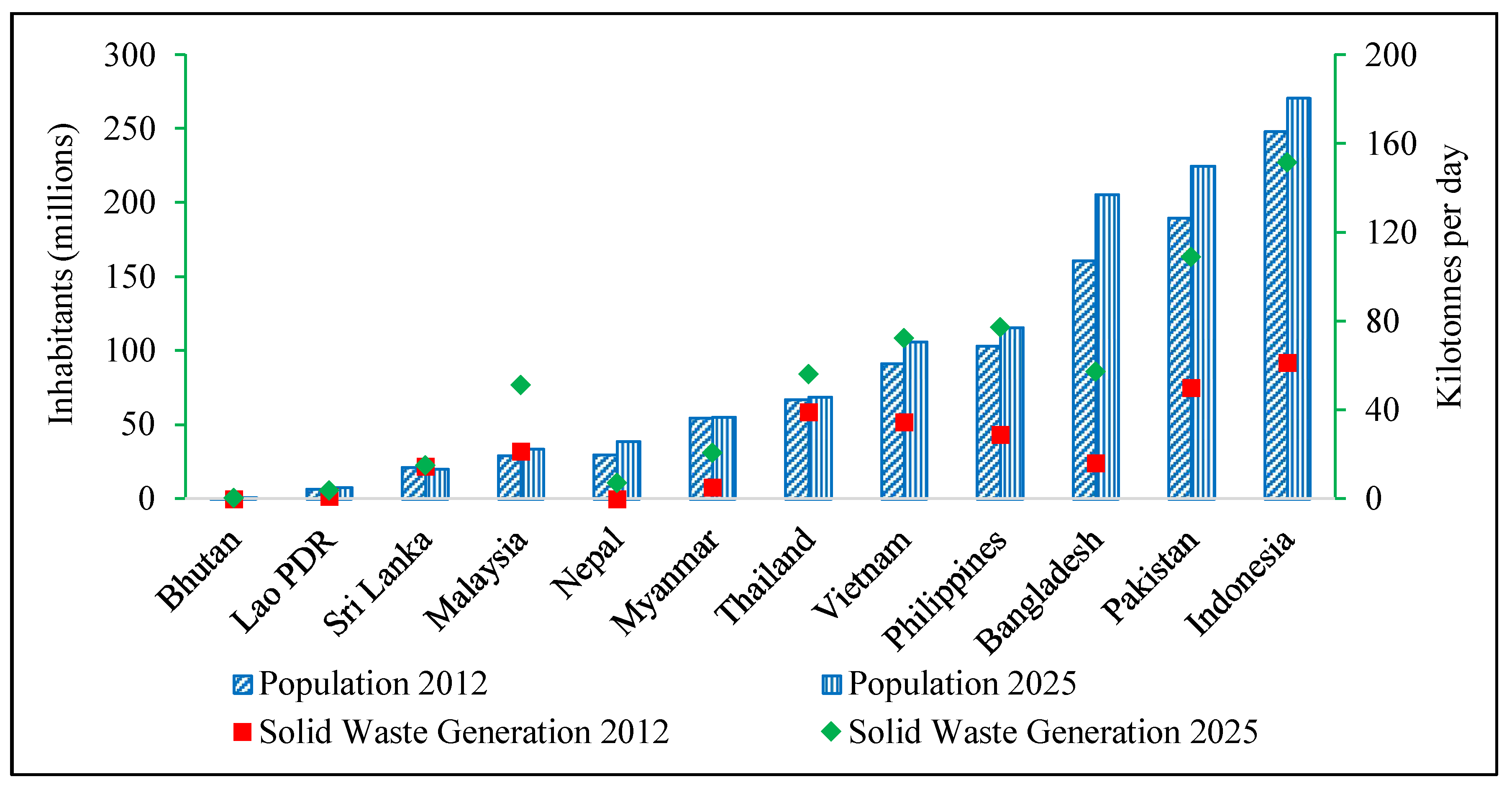
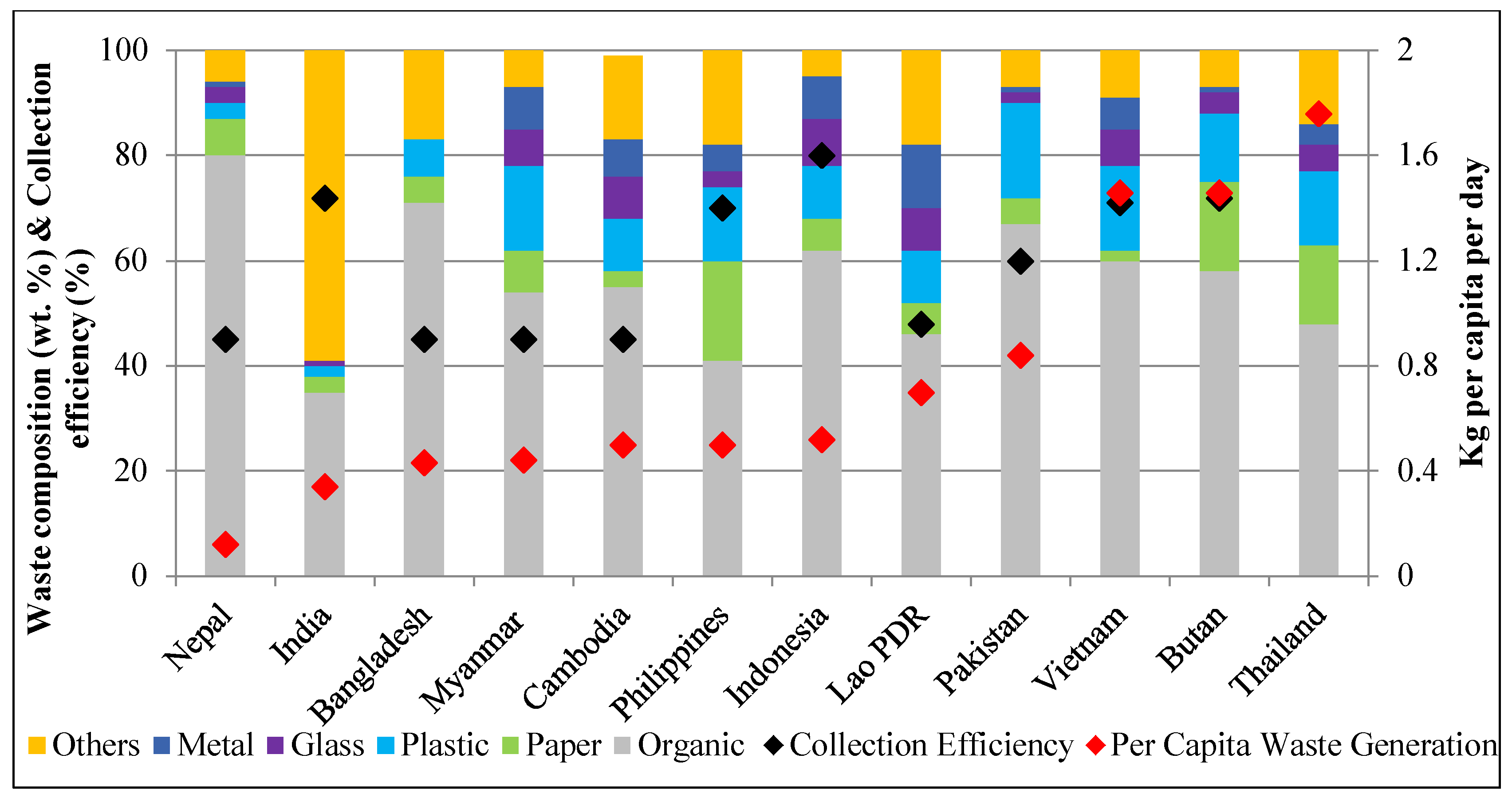
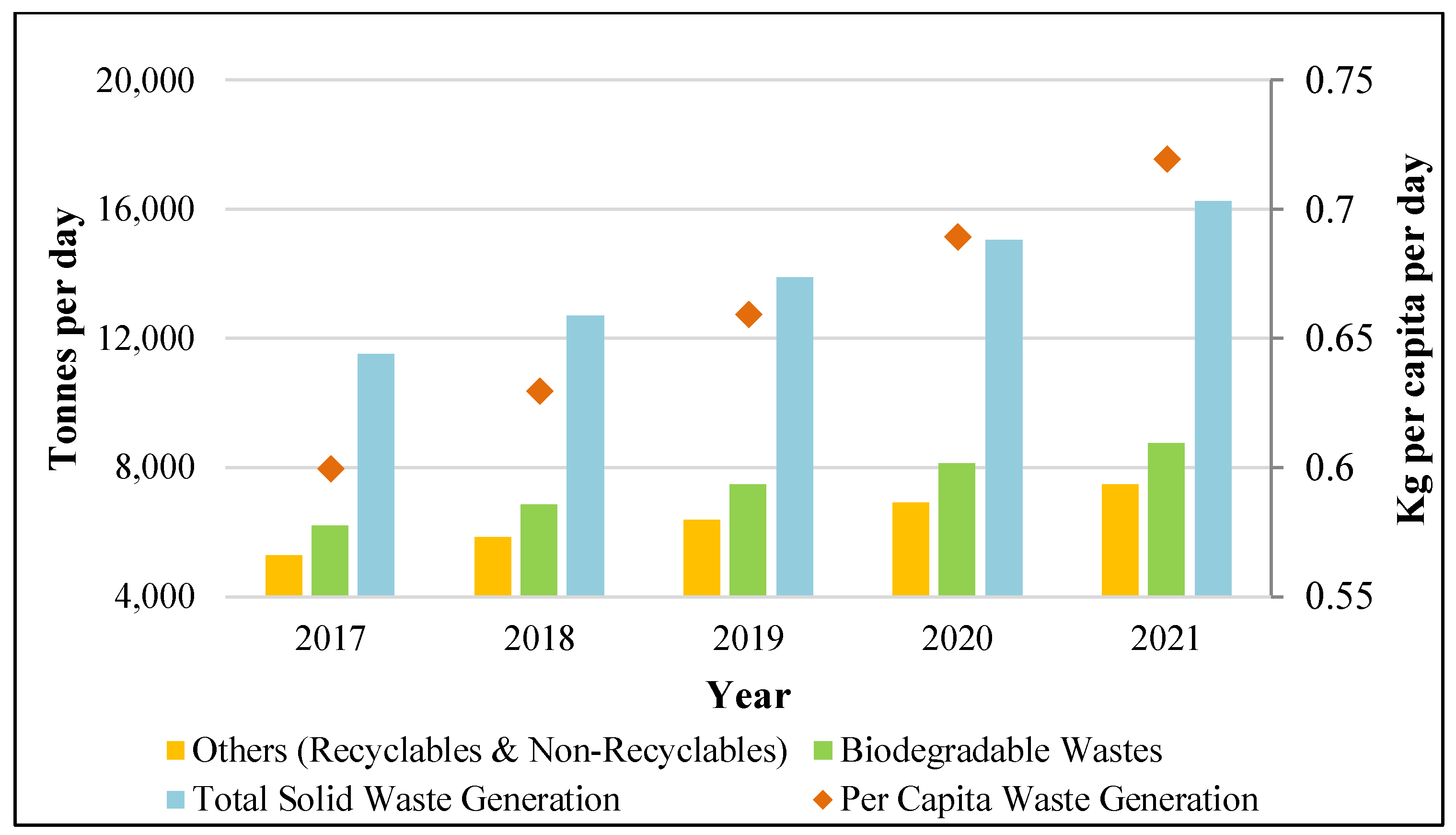
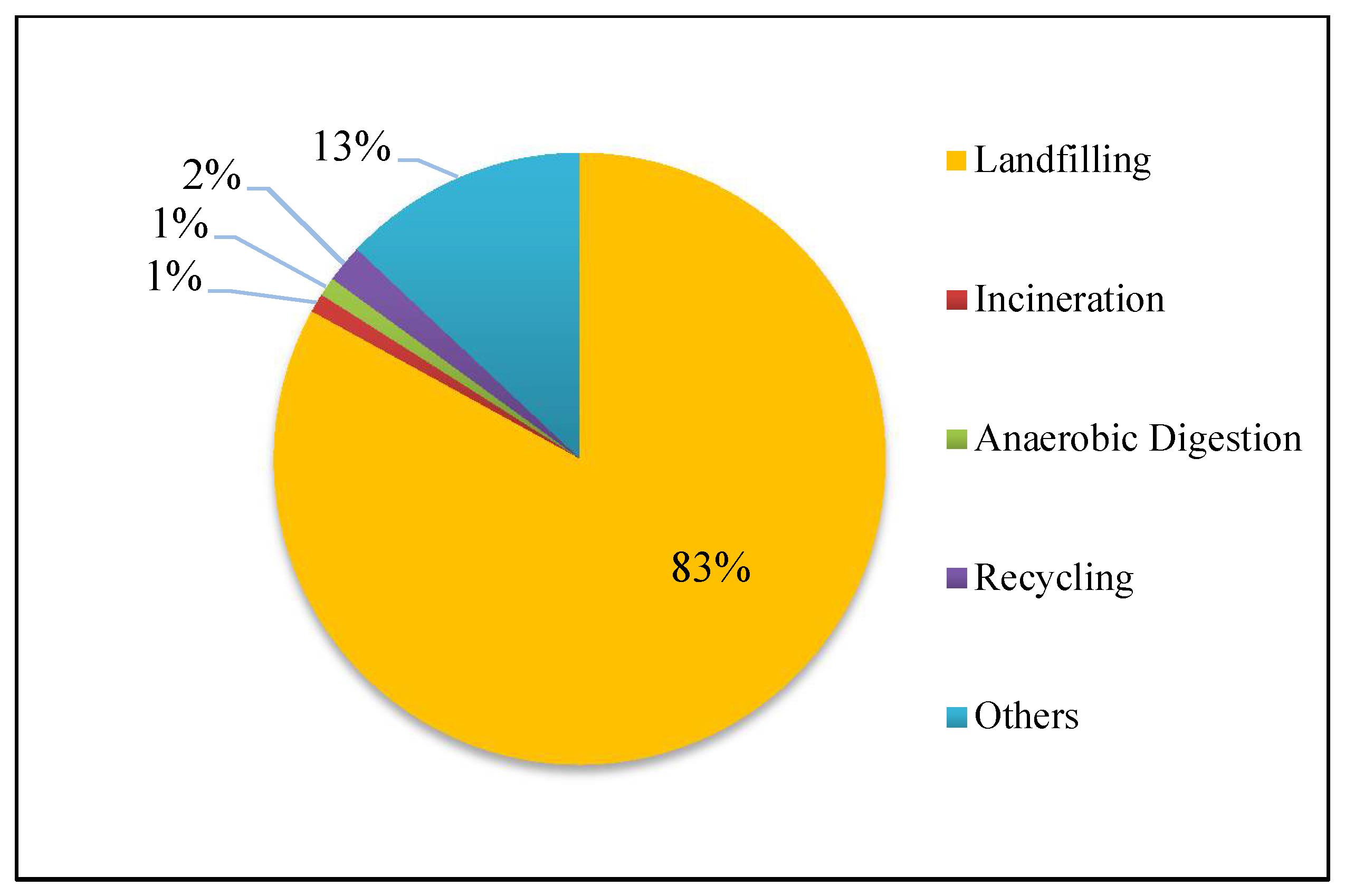
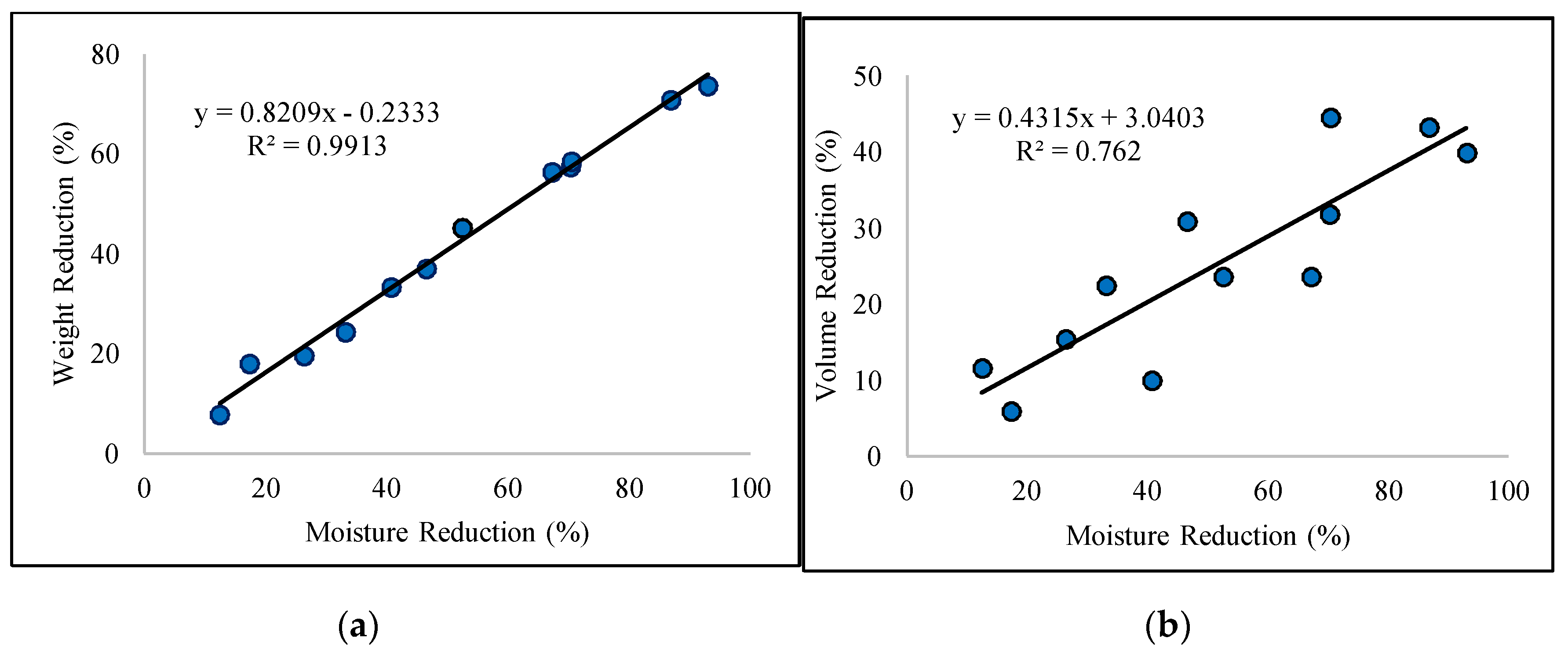
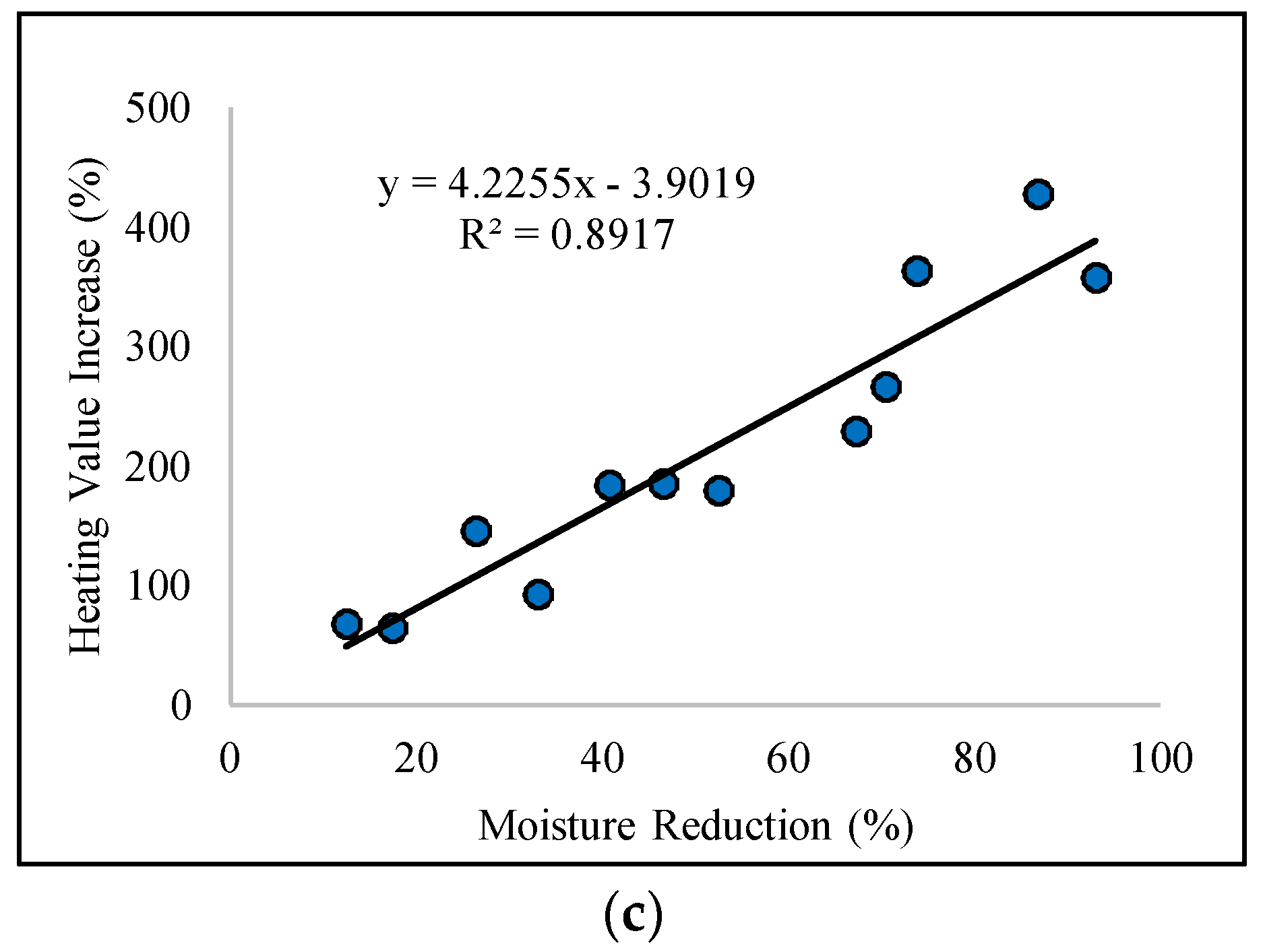

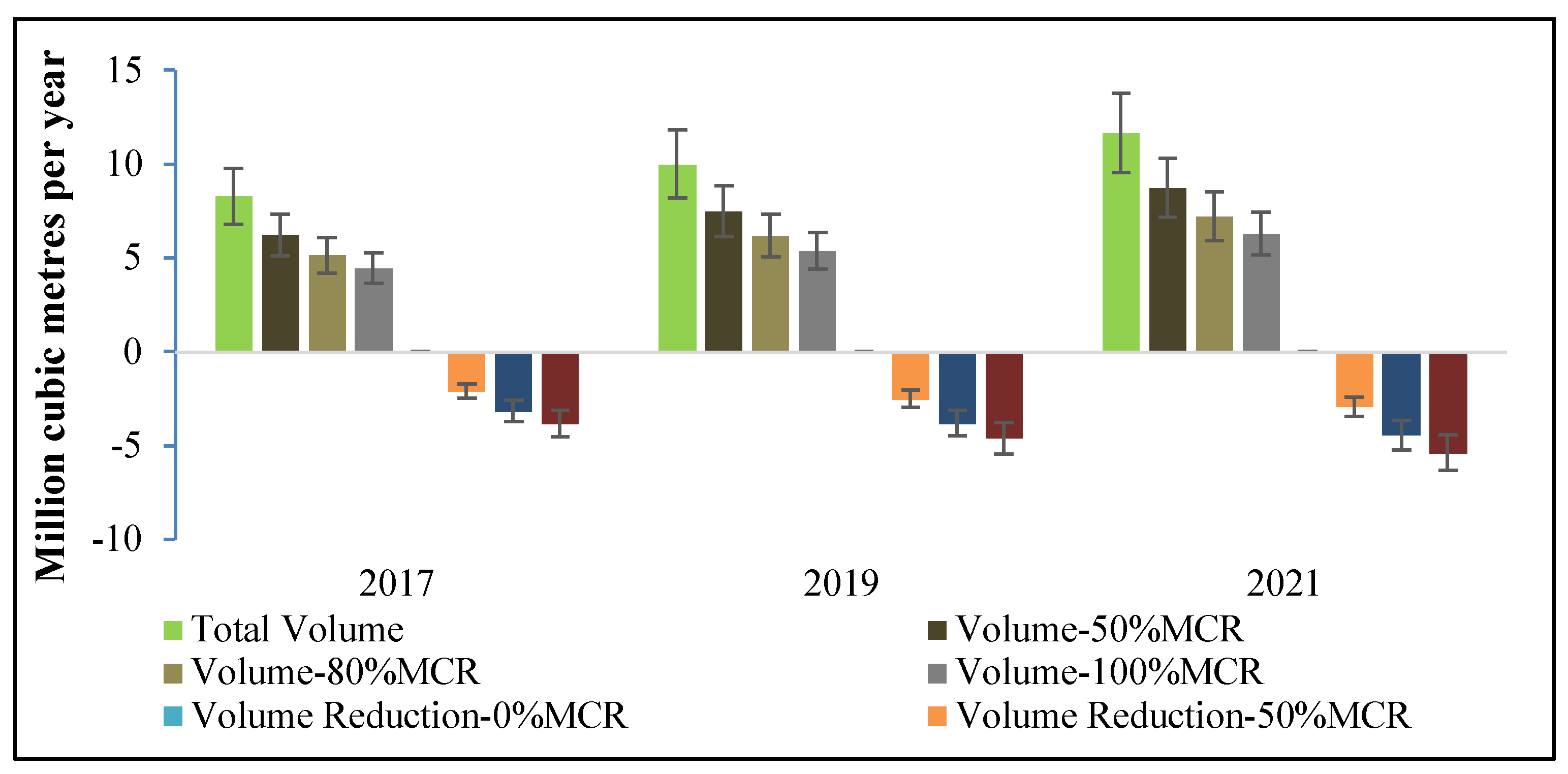
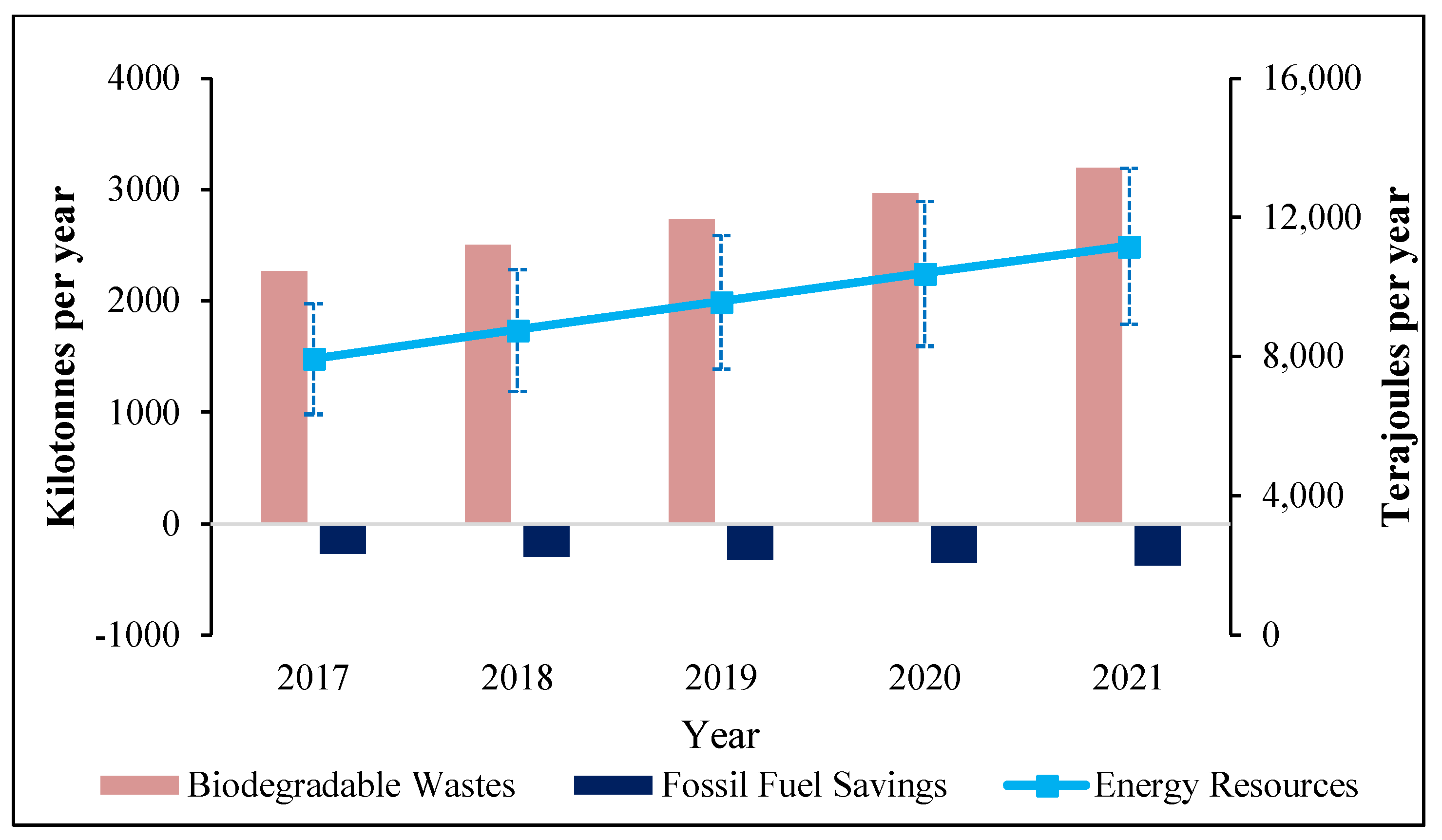


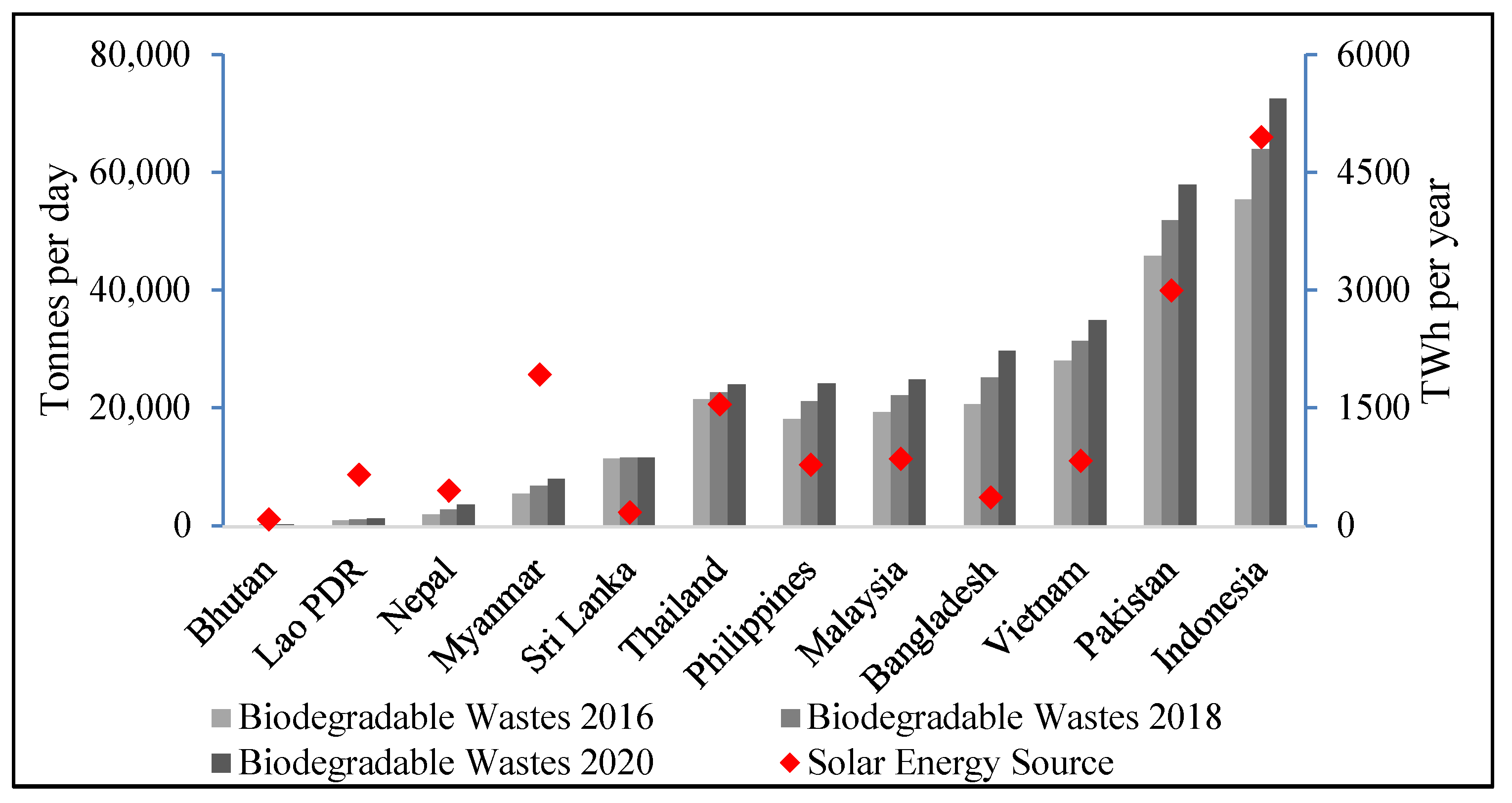
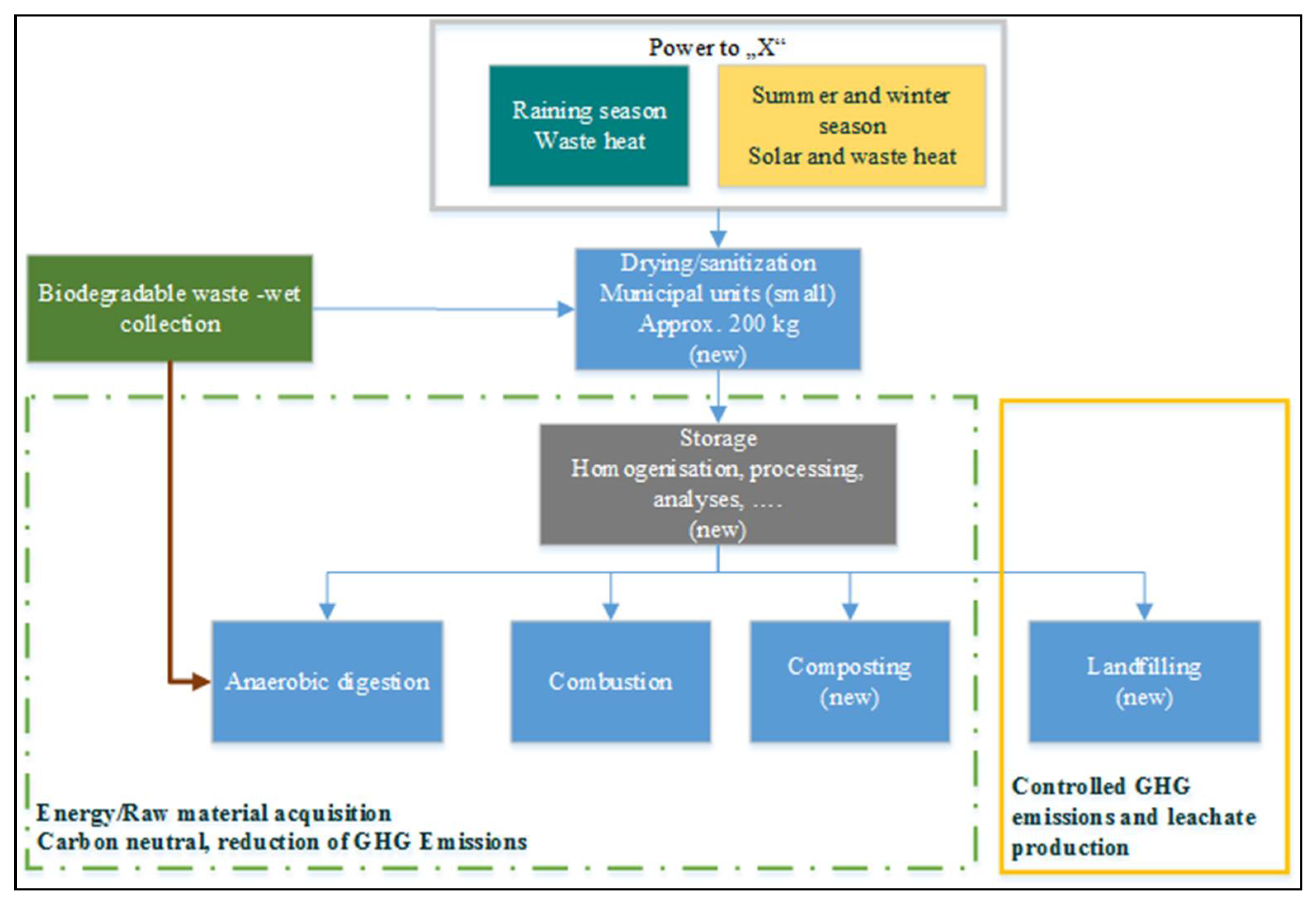
| Description | Quantity |
|---|---|
| Number of samples | 12 |
| Total amount of each sample (g) | 500 |
| Composition ratio (Food wastes: Green leaves/Garden wastes) | 80:20 |
| Density (kg/m3) | 274 ± 50 |
| Moisture content (%) | 80 ± 4 |
| LHV (MJ/kg) | 4 ± 1 |
| Sample No. | Biodegradable Waste Properties | ||||||||
|---|---|---|---|---|---|---|---|---|---|
| Initial Mass (g) | Final Mass (g) | Mass Reduction (%) | Initial Volume (10−6 m3) | Final Volume (10−6 m3) | Initial Moisture (%) | Final Moisture (%) | Initial LHV (MJ/kg) | Final LHV (MJ/kg) | |
| 1 | 500 | 110 | 78 | 1100 | 500 | 82.00 | 4.00 | 3.15 | 16.80 |
| 2 | 500 | 166 | 67 | 1800 | 1300 | 79.11 | 15.20 | 3.66 | 14.84 |
| 3 | 500 | 145 | 71 | 1850 | 1050 | 83.15 | 11.00 | 2.95 | 15.58 |
| 4 | 500 | 144 | 71 | 1550 | 1100 | 71.20 | 10.80 | 5.04 | 15.61 |
| 5 | 500 | 182 | 64 | 1700 | 1300 | 77.42 | 18.40 | 3.95 | 14.28 |
| 6 | 500 | 224 | 55 | 1300 | 900 | 84.73 | 26.80 | 2.67 | 12.81 |
| 7 | 500 | 250 | 50 | 2000 | 1800 | 81.96 | 32.00 | 3.16 | 11.90 |
| 8 | 500 | 157 | 69 | 1800 | 900 | 79.11 | 13.40 | 3.66 | 15.16 |
| 9 | 500 | 206 | 59 | 2350 | 1300 | 80.00 | 21.20 | 3.50 | 13.79 |
| 10 | 500 | 180 | 64 | 1675 | 900 | 73.73 | 9.63 | 4.60 | 15.81 |
| 11 | 500 | 129 | 74 | 2500 | 1500 | 85.44 | 11.24 | 2.55 | 15.53 |
| 12 | 500 | 131 | 74 | 2288 | 1375 | 79.44 | 5.58 | 3.60 | 16.52 |
| 500 ± 0 | 169 ± 42 | 66 ± 8 | 1826 ± 8 | 1160 ± 342 | 80 ± 4 | 15 ± 8 | 4 ± 1 | 15 ± 1 | |
| Description | Weight Reduction | Volume Reduction | Heating Value Increase | |
|---|---|---|---|---|
| Moisture Reduction | Correlation Coefficient | 0.99 | 0.87 | 0.94 |
| Sample Size | 12 | 12 | 12 | |
| p value | 0.00000 | 0.00021 | 0.00000 |
| Waste Disposal Methods | Types of Wastes Treated | Separation Work | Waste Disposal Cost (USD per tonne) | Energy Potential (kWh per tonne) | Possibility of Resource Recovery | Working Skills and Technologies | Economic Benefits (Viewed from Benefits of the Environment and Public Health) | GHG Emissions/Leachate Production | GHG Avoidance | Environmental Impact |
|---|---|---|---|---|---|---|---|---|---|---|
| Incineration | Mixed MSW (Biodegradable Wastes + Other Combustible Wastes) | Needed | 40–200 [2] | 585 | Yes | Highly needed | High |
|
| Comparatively lower |
| Anaerobic Digestion | Food wastes/Green leaves (Biodegradable Wastes) | Highly needed | 20–150 [2] | 730–1300 (for dry ton of food waste) | Yes | Highly needed | High |
|
| Comparatively lower |
| Composting | Food wastes/Green leaves (Biodegradable Wastes) | Highly needed | 5–90 [2] | - | Yes | Needed | High |
|
| Comparatively lower |
| Landfilling | Mixed MSW (Biodegradable Wastes + Others) | No needed | 10–100 [2] | 105 | No | Needed | High |
|
| High |
| Open Dumping | Mixed MSW (Biodegradable Wastes + Others) | No needed | 2–10 [2] | - | No | No needed | Low |
| - | Very high |
© 2018 by the authors. Licensee MDPI, Basel, Switzerland. This article is an open access article distributed under the terms and conditions of the Creative Commons Attribution (CC BY) license (http://creativecommons.org/licenses/by/4.0/).
Share and Cite
Tun, M.M.; Juchelková, D.; Raclavská, H.; Sassmanová, V. Utilization of Biodegradable Wastes as a Clean Energy Source in the Developing Countries: A Case Study in Myanmar. Energies 2018, 11, 3183. https://doi.org/10.3390/en11113183
Tun MM, Juchelková D, Raclavská H, Sassmanová V. Utilization of Biodegradable Wastes as a Clean Energy Source in the Developing Countries: A Case Study in Myanmar. Energies. 2018; 11(11):3183. https://doi.org/10.3390/en11113183
Chicago/Turabian StyleTun, Maw Maw, Dagmar Juchelková, Helena Raclavská, and Veronika Sassmanová. 2018. "Utilization of Biodegradable Wastes as a Clean Energy Source in the Developing Countries: A Case Study in Myanmar" Energies 11, no. 11: 3183. https://doi.org/10.3390/en11113183
APA StyleTun, M. M., Juchelková, D., Raclavská, H., & Sassmanová, V. (2018). Utilization of Biodegradable Wastes as a Clean Energy Source in the Developing Countries: A Case Study in Myanmar. Energies, 11(11), 3183. https://doi.org/10.3390/en11113183








